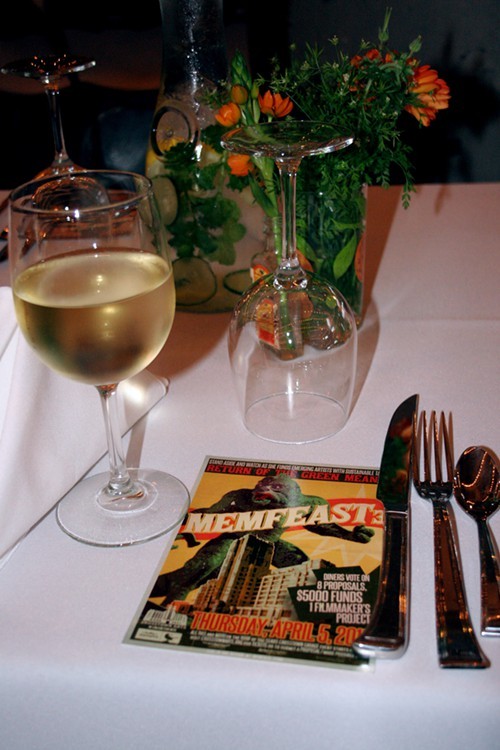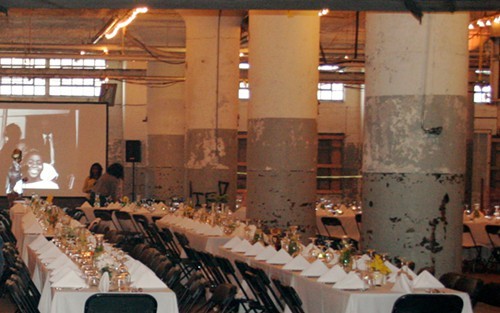
Crosstown Arts recently put on the third annual MemFeast in collaboration with Indie Memphis in the cavernous domain of the Sears Crosstown building’s lowest level. This time around, projects were limited to film and devoted entirely to the unifying theme of “neighborhood.”

While most of the selected filmmakers chose a more straightforward, traditional approach, with documentaries and narratives based inside the borders of a specific neighborhood, some branched out to the greater concept of the Memphis community as a whole. Out of eight hand-picked proposals, stretching across the city from Binghampton to Vance Avenue, the work of Nicki Newberger, Alan Spearman, Mark Adams, Morgan Jon Fox, and Sean Faust was chosen by the audience of more than 250 locals to receive a $5,000 grant – funded by ticket sales from the event as well as sponsor donations.
The exceptionally talented collaboration took a unique and somewhat risky strategy, producing a sort of preview of the film to come. April will tell the story of a 9-year-old girl living in what has become the marginalized neighborhood of Soulsville, the former site of Stax Records and current home to the Stax Museum of American Soul Music.
Named after a special tree in the area that the little girl turns to as a source of shelter and comfort, her tale of hope mixed with fear is juxtaposed against the hard reality of a middle-aged woman in failing health and ever-dwindling opportunity within the same boundaries, to merge the compelling story-telling of a narrative format with the unyielding truth of a documentary.
In line with the overall focus, Paul Taylor of the Stax Music Academy will compose the soundtrack for April, with plenty of input from his students. The completed film is set to premiere at this year’s upcoming Indie Memphis Film Festival, on Nov. 1-4.
The medium of film is decidedly close to the heart of one of Crosstown’s founders, Christopher Miner. An artist himself, Miner came to film after a roundabout career that primarily focused on photography and writing. With the organization’s goal of inspiring creative dialogue about Memphis through film, and the unshakeable power of April‘s preview in mind, we spoke with Miner about his personal views on art and the fundamental vision of Crosstown Arts.
What is your background as an artist?
I grew up in Jackson, Mississippi and went to the University of Tennessee at Knoxville for my undergrad degree, studying photography and creative writing. Then, I went for a Master’s degree in teaching English as a second language, thinking I would go back to Mexico — where I did a photo project as my undergrad thesis — but while I was there I ended up studying creative writing with Barry Hannah and writing fiction for my master’s degree. The next year I went to Yale for graduate school in photography. We had an assignment for the whole class to make something other than what you normally do. The point was to shake up your mode of work.
When I would show my photographs in critiques at Yale, the major criticism was that my stories were more interesting than the pictures themselves, so for this assignment somebody suggested that I make a video. All of my work prior to this point was traditional black and white photography: in my process I would just walk around and get mixed up with any kind of situation, sort of in explorer mode. I had never decided what my work was going to be about before I made it, I’d always just go out and discover something. Basically, that video ended up being like the cornerstone of my art career. It was in the greater New York show at MoMA PS1, and pretty much everything, even the content of my work flowed from this one starting point.
I finished at Yale in 2000 and all my friends were moving to New York, to be famous and successful in the art world, and I just wanted to live in Memphis. It’s the coolest, most perfect place in the world. It’s Southern and random and eclectic. When I came to Memphis from New Haven I had this idea that I should start a nonprofit to teach photography to kids, but I had no idea who to connect with or what to do. I was trudging all over town looking at old buildings, and — it was fully naive — I sat in the parking lot of the Sears building and had no idea what it was, thinking it would be an amazing place to do something with.
Why did you choose Memphis?
I moved back to New York and ended up teaching photography at Hunter College and video at Yale for a couple of years. Then we moved back to the South. It feels like in this city there’s a figure from a movie around all the time, the whole place feels like a set. It’s real-world stuff, and there’s an authenticity to the people.
What led to the formation of Crosstown?
I left New York with my wife, Amanda, and moved to Mississippi to help run my dad’s business when he was diagnosed with multiple melanoma. He owned health clubs in Jackson, and actually, it’s kind of crazy how much that involvement has helped with our project. I think this opportunity wouldn’t have even come about if I hadn’t had some experience in business.
My wife and I got married in Clarksdale and had a big wedding weekend at the Shack Up Inn. All of our friends from New York needed somewhere to stay, so we found this perfect place, and I got to be friends with the owner. He has a building on the property that’s an old feed-house and didn’t know what he was going to do with it. I thought it would make a great artist residency program, so I started a non-profit organization in Jackson to put a program in this feed-house.
In New York I was surrounded by a big art world, and I didn’t think I needed any of that stuff to be an artist. Jackson was an opportunity to have all this space and time, but within months I was devastated. I didn’t realize that seeing my friends and going to their shows kept me engaged. The idea was to bring in artists from all over the world to Mississippi to be a source of inspiration there.
I came to Memphis to talk to Todd Richardson about it, we had been friends for a long time. The people who were affiliated with the Sears building heard about the idea for the feed-house, and also knew that Todd had been talking about how the Sears building could be used. Things like MASS MoCA and other large-scale industrial recaptures of old buildings for arts purposes were happening at the same time, so Todd and I decided to put a plan together.
What are your goals for the organization?
The thing people don’t totally understand about the building is that it’s over a million square feet. It’s monstrous. It’s more like an urban village with a major emphasis on the arts inside. Studio space for artists was not even a part of our original concept. Rent is one thing that nobody is hard up for in Memphis, that’s not the point. It includes a residential program, a gallery space dedicated to bringing art to Memphis, with an equal amount of attention placed on exhibition opportunities for local artists. Then there’s plans for an art-making facility, sort of like shared labs for local artists so that people like you and me don’t have to go out and buy a kiln.
Why did you choose to pursue art?
I am naturally inclined to operate in an imaginary place more than a real one. As making art takes shape, it’s that same impulse that the world makes more sense in a kind of fictionalized version, like how a movie makes more sense than reality sometimes because it can get at some higher truth in a more accentuated way.